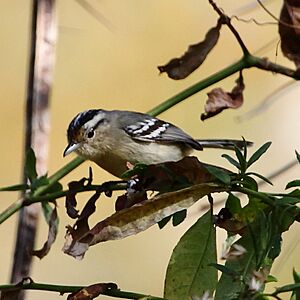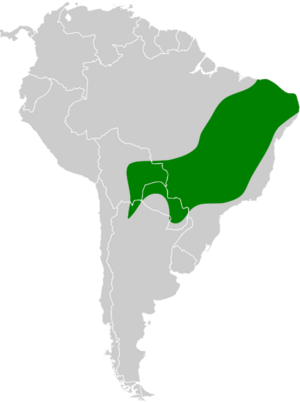Black-capped antwren facts for kids
Quick facts for kids Black-capped antwren |
|
|---|---|
 |
|
| Female at Dourado, São Paulo State, Brazil | |
| Conservation status | |
| Scientific classification | |
| Genus: |
Herpsilochmus
|
| Species: |
atricapillus
|
 |
|
The black-capped antwren (Herpsilochmus atricapillus) is a small bird that belongs to a group called "typical antbirds." You can find this bird in parts of Argentina, Bolivia, Brazil, and Paraguay.
Contents
About the Black-capped Antwren
How Scientists Name Birds
This bird was first described by an Austrian bird expert named August von Pelzeln in 1868. He gave it its scientific name, Herpsilochmus atricapillus. The black-capped antwren is closely related to another bird called the Bahia antwren. It is also a monotypic species, which means it doesn't have different subspecies.
What Does It Look Like?
The black-capped antwren is about 11 to 12 centimeters (4.3 to 4.7 inches) long. It weighs between 8 and 11 grams (0.28 to 0.39 ounces). That's about the weight of a few paper clips!
Male black-capped antwrens have a black cap on their head and a black stripe through their eye. They have a white or light gray stripe above their eye. Their back is gray, and their wings are black with white tips. Their tail is black with white tips on the feathers. Their belly is mostly light gray.
Female black-capped antwrens look a bit different. They have a brownish forehead and a black and white striped cap. Their back is gray with a hint of olive green. Their belly is white, sometimes with a pale yellow-brown color on their chest. Both male and female birds can have slight differences in how dark or bright their colors are.
Where Does It Live?
You can find the black-capped antwren in several countries in South America. These include parts of Brazil, southeastern Bolivia, northwestern Argentina, and northern and eastern Paraguay.
This bird lives in many types of forests. These include forests that lose their leaves in certain seasons, forests that stay green all year, and forests along rivers. In northeastern Brazil, it likes a type of woodland called caatinga and humid evergreen forests.
It can live from sea level up to about 800 meters (2,600 feet) high. However, near the Andes mountains in Bolivia and Argentina, it can be found as high as 1,450 meters (4,760 feet).
Black-capped Antwren Behavior
Does It Move Around?
Scientists believe that the black-capped antwren stays in the same area all year long. It does not migrate to different places.
What Does It Eat?
The black-capped antwren mainly eats insects. It probably eats spiders too. These birds usually look for food alone, in pairs, or in small family groups. They often join "mixed-species feeding flocks." This means they hunt for food with other types of birds.
They typically look for food high up in the trees, about 7 to 20 meters (23 to 66 feet) above the ground. However, they might feed lower down at the edge of the forest. They usually grab their prey from leaves, vines, and branches. They might reach out from a perch or make short flights to catch insects. They are not known to follow army ants, which some other antbirds do.
How Does It Raise Its Young?
We don't know much about how black-capped antwrens raise their babies. We do know that adult birds have been seen feeding young birds in Brazil during January and February.
What Does Its Song Sound Like?
The black-capped antwren's song changes a little depending on where the bird lives. Generally, it starts with one or two clear notes. Then it quickly turns into a fast series of notes that go up and down in pitch. This series of notes also slows down towards the end.
It also has a "rattle song," which is a series of short, complex notes. Its calls include a sharp, downward-sloping note. It also makes a longer note that rises and falls in pitch.
Is the Black-capped Antwren in Danger?
The IUCN (International Union for Conservation of Nature) has listed the black-capped antwren as a species of "Least Concern." This means it is not currently in danger of extinction.
It lives across a very large area. Even though its population size is unknown, it is thought to be decreasing. However, no immediate threats have been found. This bird is considered fairly common to common throughout its range. It is also not very sensitive to human changes in its habitat. Its home range includes several large protected areas, which helps keep it safe.


